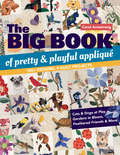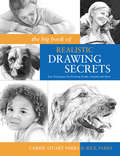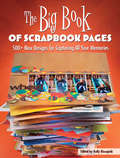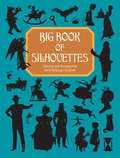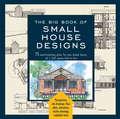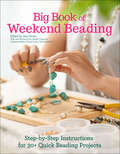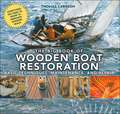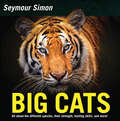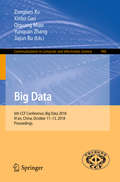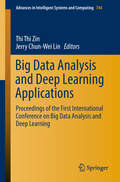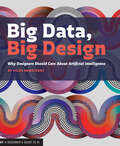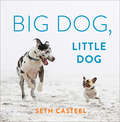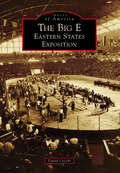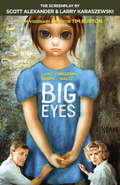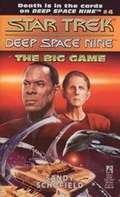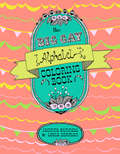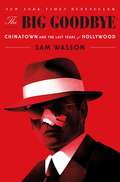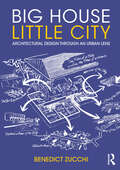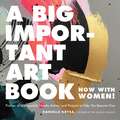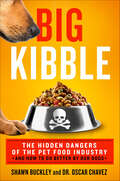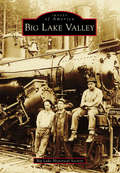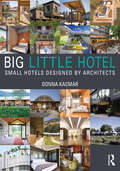- Table View
- List View
Big Book of Pretty & Playful Appliqué: 150+ Designs, 4 Quilt Projects Cats & Dogs at Play, Gardens in Bloom, Feathered Friends & More
by Carol ArmstrongAdd a lively touch of nature to your quilting with this massive collection of realistic flora and fauna appliqué designs. Carol Armstrong's stunning garden quilts and true-to-life critters have changed the way we appliqué. Now her best work is featured together in a single volume—a treasure trove of appliqué delights! Sew one hundred and sixty patterns from blooming flowers and birds in flight to household pets as loveable as your own dog or cat. Learn how to trace designs using a lightbox, and practice with four projects to showcase any combination of designs.
The Big Book of Realistic Drawing Secrets: Easy Techniques for drawing people, animals, flowers and nature
by Carrie Stuart Parks Rick ParksThis is the book that can teach anyone to draw (yes, even you!) If you're not getting the kind of true-to-life results you want in your drawings (or if you can't even draw a straight line), Carrie and Rick Parks can help. As award-winning teachers, they have a proven game plan for helping artists of all levels overcome common problems and see immediate improvement in their work. As professional composite artists, they know the tricks and tools for achieving incredibly lifelike results. In this friendly, foolproof guide to drawing, they share it all: Easy-to-master techniques for achieving a convincing sense of depth How to draw challenging textures like metal and fur Putting personality into your portraits 40+ step-by-step demonstrations featuring a variety of people, animals and nature Easy enough so that beginners can jump right in, and comprehensive enough to help more accomplished artists refine their skills. This book covers all the essentials, teaching you the secrets of realistic drawing one step at a time, building the skills you need to tackle any subject convincingly--even those you've always thought were beyond your reach. Before you know it, you'll be turning out picturesque landscapes, stellar portraits--any subject that inspires you to put pencil to paper!
The Big Book of Scrapbook Pages: 500+ New Designs for Capturing All Your Memories
by Kelly BiscopinkPage After Page of Inspiration!If you're feeling overwhelmed with stacks of photos, or stuck in a scrapbooking rut, look no further for answers and inspiration! The Big Book of Scrapbook Pages will help you find the creative spark, and motivate you to try exciting new things in your layouts. Inside, you'll find:Over 500 never-before-seen traditional, digital hybrid layouts50 sketches for both 12 x 12 and 8 1/2 x 11 pagesHints, tips and creative ideas for enhancing your layoutsA variety of topics and themes, including: birthdays, holidays, seasons, babies and kids, pets and special occasionsDon't be discouraged - get inspired with The Big Book of Scrapbook Pages!For more inspiration visit memorymakersmagazine. com
Big Book of Silhouettes
by Carol Belanger GraftonAn ancient art form dating back to cave paintings in the Paleolithic age, silhouettes were extremely popular during the eighteenth and nineteenth centuries, when they served as an inexpensive form of portraiture, capturing the essence of the subject with a minimum of detail.Now today's crafters, designers, artists, and illustrators can take advantage of the silhouette's eye-catching power with this splendid sourcebook, meticulously compiled by Carol Belanger Grafton. Included are over 1,700 charming, royalty-free silhouettes — culled from a number of rare sources — ideal for use in a broad range of graphic projects. Posters, signage, magazine and book illustration, advertisements, brochures, and flyers are just a few of the potential uses for the illustrations in this convenient archive.Choose from a wide array of subjects: animals portrayed in assorted poses, children playing and reading, couples embracing, views of the human profile, people working, painting, biking, and playing musical instruments; and many more. All appear in striking forms that emphasize the silhouette's power to make a simple but bold graphic statement.
Big Book of Small House Designs: 75 Award-Winning Plans for Your Dream House, 1,250 Square Feet or Less
by Don Metz Catherine Tredway Lawrence Von Bamford Kenneth R. Tremblay75 unique designs for attractive, efficient, environmentally friendly homes. Now available in paperback, this collection of 75 plans for small homes offers more than 500 usable blueprints and other illustrations for a variety of living spaces suitable for every environment and style, from a New England farmhouse to a sophisticated townhouse in the city to a Santa Fe ranch. The designs include site drawings, floor plans, elevation drawings, section drawings, perspective drawings, and exploded views. A brief introduction to each home describes its setting, the philosophy behind the design and its intended use, materials used, recommended landscaping, and more. Many of the homes come with money-saving and environmentally sound features such as solar panels and water heaters, wood stoves, ceiling fans, airlock entries, wind power alternatives, and natural gas heaters.
Big Book of Weekend Beading: Step-by-Step Instructions for 30+ Quick Beading Projects
by Jean Power&“There&’s plenty of variety in both style and technique here, making this an appropriate choice for crafters looking to sample different methods for beading.&” —Library Journal Discover the amazing versatility of beadwork in this scintillating selection of more than thirty projects that you can make in just one weekend. From jewelry and clothing to home accessories and embroidered textiles, there&’s something here for every taste and level of ability. Projects include lampshades, decorative candles, fringed throws, embroidered table runners, tassel covers, embellished scarves, hair accessories, and more. Big Book of Weekend Beading teaches an exciting variety of methods, from general beadwork to stringing, bead embroidery, and wirework. Simple projects at the start of each section give beginners an instant taste of success, leading them on to try larger-scale projects and more impressive techniques. The projects and techniques are designed and written by a team of experienced bead crafters, each one an expert in her field.&“A first-class instruction manual for a popular pastime that is sweeping the nation, a perfect activity for quiet winter weekends.&”—The Midwest Book Review&“If you enjoy using beads or want to learn how to do beading, the Big Book of Weekend Beading by Jean Powers is the perfect place to start.&”—Kelly&’s Thoughts on Things
The Big Book of Wooden Boat Restoration: Basic Techniques, Maintenance, and Repair
by Thomas LarssonAn excellent manual for embarking on a wooden boat restoration project.The Big Book of Wooden Boat Restoration is the perfect introduction or reference guide for both novice and experienced wooden boat enthusiasts. Author Thomas Larsson, one of Sweden’s most experienced and premier wooden boat restorers, has compiled his knowledge of the craft for readers and placed it in this book. This ultimate guide to restoration contains useful facts and an extensive glossary, accessible to both new hobbyists and longtime boat lovers.Also within this book are chapters on boat care, including winter maintenance, racing, finishing, and stripping. Additionally, there is updated information on boat building, gluing, and tools. The most extensive part of this book consists of chapters that describe the detailed clean repair of wooden boats-everything from plug accession and bonding to changing socks and bottom engine installation.Larsson includes a history of boat building and provides a nice glimpse of different wooden boats with more than two hundred sketches and photos in both color and black-and-white. He explains how staying on top of maintenance keeps a unique fleet of wooden boats alive. With practical instructions and fact boxes with advice and tips, this book will teach you all about maintenance: surface treatment, scraping the hull, equipping the boat in the spring, and looking after it in the winter. Also included are tips on buying a boat, installing an engine, and more.Skyhorse Publishing, as well as our Sports Publishing imprint, is proud to publish a broad range of books for readers interested in sports-books about baseball, pro football, college football, pro and college basketball, hockey, or soccer, we have a book about your sport or your team.In addition to books on popular team sports, we also publish books for a wide variety of athletes, including books on running, cycling, horseback riding, swimming, tennis, martial arts, golf, camping, hiking, aviation, boating, and so much more. While not every title we publish becomes a New York Times bestseller or a national bestseller, we are committed to publishing books on subjects that are sometimes overlooked by other publishers and to authors whose work might not otherwise find a home.
Big Cats: Revised Edition
by Seymour SimonIn this completely updated edition of Big Cats, award-winning writer Seymour Simon celebrates the grace and power of lions, tigers, leopards, jaguars, cheetahs, pumas, and snow leopards. Readers will learn all about how they hunt, care for their young, and rest in their varied natural habitats. This nonfiction picture book is packed with information and beautiful color photographs. Cat fans and kids ages 6 to 10 looking for facts, whether for a report or just for fun, will find much to like in Big Cats.This updated edition includes:Author’s noteStunning full-color photographsGlossaryIndexAdditional reading sourcesSupports the Common Core Learning Standards, Next Generation Science Standards, and the Science, Technology, Engineering, and Math (STEM) standards.
The Big Cloud
by Camille Seaman Alan BurdickOur culture is addicted to weather: hourly forecasts, apps, radio, TV channels, alerts, warnings, and watches. And understandably—our food, clothing, livelihoods, and, increasingly, safety are tied directly to the weather and climate change. In The Big Cloud, photographer Camille Seaman stands in front of tornados, at the edges of lightning storms, and in pelting hail under pitch-black skies to capture supercells and mammatus clouds in their often sublime and terrifying splendor. In these awe-inspiring photographs, Seaman's work is a potent reminder that there is no art more dramatic, in scale or emotion, than that created by nature. Big Cloud includes an introduction by award-winning New Yorker science writer and author Alan Burdick (Out of Eden, Why Time Flies).
Big Data: 6th CCF Conference, Big Data 2018, Xi'an, China, October 11-13, 2018, Proceedings (Communications in Computer and Information Science #945)
by Zongben Xu Xinbo Gao Qiguang Miao Yunquan Zhang Jiajun BuThis volume constitutes the proceedings of the 6th CCF Conference, Big Data 2018, held in Xi'an, China, in October 2018. The 32 revised full papers presented in this volume were carefully reviewed and selected from 880 submissions. The papers are organized in topical sections on natural language processing and text mining; big data analytics and smart computing; big data applications; the application of big data in machine learning; social networks and recommendation systems; parallel computing and storage of big data; data quality control and data governance; big data system and management.
Big Data Analysis and Deep Learning Applications: Proceedings of the First International Conference on Big Data Analysis and Deep Learning (Advances in Intelligent Systems and Computing #744)
by Thi Thi Zin Jerry Chun-Wei LinThis book presents a compilation of selected papers from the first International Conference on Big Data Analysis and Deep Learning Applications (ICBDL 2018), and focuses on novel techniques in the fields of big data analysis, machine learning, system monitoring, image processing, conventional neural networks, communication, industrial information, and their applications. Readers will find insights to help them realize more efficient algorithms and systems used in real-life applications and contexts, making the book an essential reference guide for academic researchers, professionals, software engineers in the industry, and regulators of aviation authorities.
Big Data, Big Design: Why Designers Should Care about Artificial Intelligence
by Helen ArmstrongBig Data, Big Design provides designers with the tools they need to harness the potential of machine learning and put it to use for good through thoughtful, human-centered, intentional design.Enter the world of Machine Learning (ML) and Artificial Intelligence (AI) through a design lens in this thoughtful handbook of practical skills, technical knowledge, interviews, essays, and theory, written specifically for designers. Gain an understanding of the design opportunities and design biases that arise when using predictive algorithms. Learn how to place design principles and cultural context at the heart of AI and ML through real-life case studies and examples. This portable, accessible guide will give beginners and more advanced AI and ML users the confidence to make reasoned, thoughtful decisions when implementing ML design solutions.
Big Design, Small Budget: Create a Glamorous Home in Nine Thrifty Steps
by John Ha Betsy HelmuthAs seen on the TODAY Show!Homeowners and renters of all means dream of having a beautiful home. With the lingering recession, many of us have less to work with but still long to live in style. Big Design, Small Budget makes luxury an affordable reality. In this DIY home decorating handbook, Helmuth reveals insider tips and her tried-and-tested methods for designing on a budget.In the past year, Helmuth has shared her affordable design advice and step-by-step approaches with millions through live teaching workshops, guest columns, television appearances, and interviews. Now, she has distilled her expertise into this practical guide. The chapters follow her secret design formula and include creating a design budget, mapping out floor plans, selecting a color palette, and accessorizing like a stylist.It's time to start living in the home of your dreams without maxing out your credit cards. Learn how with Helmuth's Big Design, Small Budget!
Big Dog, Little Dog
by Seth CasteelFrom the bestselling photographer behind Underwater Dogs and Underwater Puppies, a new irresistibly cute concept featuring tiny dogs and giant dogs side by side.A collection of stunning photographs, each featuring two dogs: one big, one small. These unexpected pairs are utterly adorable, making this book the perfect gift for the biggest (or littlest) dog lover in your life, or the perfect coffee-table book for anyone who loves cute pups.
Big E, The: Eastern States Exposition (Images of America)
by David CecchiThe Eastern States Agricultural and Industrial Exposition was founded more than a century ago to �promote the agricultural and industrial development of the eastern states.� Held at the fairgrounds in West Springfield, Massachusetts, the inaugural event was the National Dairy Show in 1916, followed by what would become known as �The Big E,� the combined �state fair� of the six New England states: Connecticut, Massachusetts, Maine, New Hampshire, Rhode Island, and Vermont. Weathering floods, hurricanes, the Great Depression, and two world wars, it is currently one of the largest fairs in North America, with an attendance of over 1.3 million fairgoers in 2015. With photographs spanning the past century from exposition archives, area residents, and his own collection, author David Cecchi presents a fascinating visual history of what he refers to as �the fair.�
Big Embroidery: 20 Crewel Embroidery Designs to Stitch with Wool
by Nancy NicholsonStash-busting embroidery projects for home décor, clothes, and accessories with folk art-inspired designs, by author of Modern Folk Embroidery.Big Embroidery is all about stitching beautiful designs up fast using yarn instead of embroidery thread. Designer Nancy Nicholson has created a collection of stunning designs based on traditional crewel work, and adapted them for a modern audience using everyday yarn. Crewel embroidery is traditionally done using two-ply wool and stitched onto linen. Nancy shows how to get beautiful results using different types of yarn and fabric, including upholstery fabrics, woolens, and tweeds, to create a collection of stunning quick-to-stitch projects. Choose from home decor items such as cushions, bags, wall hangings and table runners, as well as ideas for embellishing clothing. Nancy shows readers how to do all the key embroidery stitches with a stitch library featuring easy-to-follow diagrams of all the basic crewel embroidery stitches in detail.
Big Eyes
by Tyler Stallings Larry Karaszewski Scott AlexanderWITH AN INTERVIEW WITH MARGARET KEANEThe full screenplay by award-winning Ed Wood writers Scott Alexander and Larry Karaszewski for acclaimed director Tim Burton's film Big Eyes, starring Amy Adams and Christoph Waltz.A rare close-up look into a corner of the 1950s and '60s art world and a perfectly observed account of a dysfunctional marriage, Big Eyes tells the true story of Margaret Keane, an artist who lived and worked in virtual slavery while her husband, Walter, gained fame and fortune passing himself off as the creator of his wife's wildly popular paintings. The story of their toxic relationship would culminate in a Hawaiian courtroom, as Margaret ultimately fights to save her name and reclaim her art, during a heated public court battle. This edition, illustrated with photos throughout, contains the complete screenplay, an afterword by the screenwriters, and an interview with Margaret Keane, the real-life subject of Big Eyes, by Tyler Stallings.
The Big Game (Star Trek: Deep Space Nine #Vol. 4)
by Sandy SchofieldWhen Quark holds a poker tournament on Deep Space NineTM someone from almost every sentient race -- Klingons, Cardassians, Romulans, Vulcans, Ferengi -- shows up for what is sure to be the highest-stakes game of all time. But when one player is killed, the stakes get higher than even these big-money players had counted on. With the station rocked by subspace waves that threaten its destruction, Commander Sisko and Security Chief Odo must hunt down the killer in time to save the players, a killer who has information that can save those onboard Deep Space Nine from the invisible enemy they do not even know they face, a killer who holds all the cards...
The Big Gay Alphabet Coloring Book (Reach and Teach)
by Jacinta BunnellGrab your crayons and your backpack for a fantastical journey through The Big Gay Alphabet Coloring Book, an activity book for adults that highlights memorable victories and collective moments in lesbian, gay, bisexual, transgender, queer, questioning, and pansexual culture. Each unique page, made up of inked and framed line drawings with beautiful typography, is reminiscent of a handsomely designed, vintage children's alphabet book and aims to bring greater understanding of gender fluidity, gender diversity, and sexual orientation.
The Big Goodbye: Chinatown and the Last Years of Hollywood
by Sam WassonFrom the New York Times bestselling author of Fifth Avenue, Five A.M. and Fosse comes the revelatory account of the making of a modern American masterpiece Chinatown is the Holy Grail of 1970s cinema. Its twist ending is the most notorious in American film and its closing line of dialogue the most haunting. Here for the first time is the incredible true story of its making. In Sam Wasson's telling, it becomes the defining story of the most colorful characters in the most colorful period of Hollywood history. Here is Jack Nicholson at the height of his powers, as compelling a movie star as there has ever been, embarking on his great, doomed love affair with Anjelica Huston. Here is director Roman Polanski, both predator and prey, haunted by the savage death of his wife, returning to Los Angeles, the scene of the crime, where the seeds of his own self-destruction are quickly planted. Here is the fevered dealmaking of "The Kid" Robert Evans, the most consummate of producers. Here too is Robert Towne's fabled script, widely considered the greatest original screenplay ever written. Wasson for the first time peels off layers of myth to provide the true account of its creation. Looming over the story of this classic movie is the imminent eclipse of the '70s filmmaker-friendly studios as they gave way to the corporate Hollywood we know today. In telling that larger story, The Big Goodbye will take its place alongside classics like Easy Riders, Raging Bulls and The Devil's Candy as one of the great movie-world books ever written.Praise for Sam Wasson:"Wasson is a canny chronicler of old Hollywood and its outsize personalities...More than that, he understands that style matters, and, like his subjects, he has a flair for it." - The New Yorker"Sam Wasson is a fabulous social historian because he finds meaning in situations and stories that would otherwise be forgotten if he didn't sleuth them out, lovingly." - Hilton Als
Big House Little City: Architectural Design Through an Urban Lens
by Benedict ZucchiCombining architectural and urban thinking in an unusual and engaging way, this book presents an integrated approach to architectural theory and design. Leon Battista Alberti’s assertion in his famous Renaissance treatise that ‘the city is like a big house, and the house is in turn like a little city’ forms the springboard for a series of reflections on architecture’s relationship with urbanism and how their once intimate symbiosis, unravelled by International Style Modernism, can be recovered. Explicit references to Alberti’s house-city phrase have been made by figures as diverse as the architects Louis Kahn, Aldo Van Eyck, Denys Lasdun and Niels Torp and novelist Italo Calvino. But, as the book shows, thinking of buildings as little cities provides a new lens through which to reappraise the contributions of many other architects, including Le Corbusier, Frank Lloyd Wright, Alvar Aalto, Eliel Saarinen, Bernard Rudofsky, Hans Scharoun, Leon Krier, Fumihiko Maki, Charles Correa and Team 10. In doing so, the author identifies common themes that form an unexpected bridgehead between the urban and architectural approaches of Antiquity, the Middle Ages, Renaissance and 20th century. The book explores buildings from across the globe, including lesser-known projects, such as Wright’s unbuilt house in Italy or Saarinen’s master plan for Cranbrook Academy, as well as more recent projects by Niels Torp, Behnisch Architekten, Sou Fujimoto, Peter Barber and WOHA. It concludes with practical case studies of residential, health, education and workplace projects from different countries, fulsomely illustrated with many drawings and photographs. These show how architectural design viewed through an urban lens provides a conceptual framework for breaking down the scale of large buildings and integrating them with their context. And crucially, these also show a very accessible way of explaining evolving designs to the intended users and eliciting their participation in the design process. The book offers a compelling approach to the design of projects at all scales, within an ecological perspective: the sense that big and small, cities and buildings must be approached holistically if we are to reverse the degradation and depletion of our habitat, both natural and man-made.
A Big Important Art Book (Now with Women): Profiles of Unstoppable Female Artists--and Projects to Help You Become One
by Danielle KrysaCelebrate 45 women artists, and gain inspiration for your own practice, with this beautiful exploration of contemporary creators from the founder of The Jealous Curator. Walk into any museum, or open any art book, and you'll probably be left wondering: where are all the women artists? A Big Important Art Book (Now with Women) offers an exciting alternative to this male-dominated art world, showcasing the work of dozens of contemporary women artists alongside creative prompts that will bring out the artist in anyone!This beautiful book energizes and empowers women, both artists and amateurs alike, by providing them with projects and galvanizing stories to ignite their creative fires. Each chapter leads with an assignment that taps into the inner artist, pushing the reader to make exciting new work and blaze her own artistic trail. Interviews, images, and stories from contemporary women artists at the top of their game provide added inspiration, and historical spotlights on art "herstory" tie in the work of pioneering women from the past. With a stunning, gift-forward package and just the right amount of pop culture-infused feminism, this book is sure to capture the imaginations of aspiring women artists.
Big Kibble: The Hidden Dangers of the Pet Food Industry and How to Do Better by Our Dogs
by Shawn Buckley Oscar ChavezA big, inside look at the shocking lack of regulation within the pet food industry, and how readers can dramatically improve the quality of their dogs’ lives through diet. What's really going into commercial dog food? The answer is horrifying. Big Kibble is big business: $75 billion globally. A handful of multi-national corporations dominate the industry and together own as many as 80% of all brands. This comes as a surprise to most people, but what’s even more shocking is how lax the regulations and guidelines are around these products. The guidelines—or lack thereof—for pet food allow producers to include ever-cheaper ingredients, and create ever-larger earnings. For example, “legal” ingredients in kibble include poultry feces, saw dust, expired food, and diseased meat, among other horrors. Many vets still don’t know that kibble is not the best food for dogs because Big Kibble funds the nutrition research. So far, these corporations have been able to cut corners and still market and promote feed-grade food as if it were healthful and beneficial—until now.Just as you are what you eat, so is your dog. Once you stop feeding your dog the junk that’s in kibble or cans, you have taken the first steps to improving your dog’s health, behavior and happiness.You know the unsavory side of Big Tobacco and Big Pharma. Now Shawn Buckley, Dr. Oscar Chavez, and Wendy Paris explain all you need to know about unsavory Big Kibble—and offer a brighter path forward for you and your pet.
Big Lake Valley (Images of America)
by Big Lake Historical SocietyA beautiful lake surrounded by virgin timber was enough for Dr. Hyacinthe P. Montborne to homestead here in 1884. He set up a shingle mill at Montborne in 1887, at the same time Hugh Walker was setting up a shingle mill in Walker Valley. With the establishment of the Seattle, Lake Shore & Eastern Railroad along the shoreline of Big Lake, the valley began to boom. The Day Lumber Company at Big Lake and the Nelson Neal Lumber Company at Montborne each established lumber mills. Their operations were far-reaching into the vast timberlands. With families homesteading near and far, the Finn Settlement, Ehrlich, Big Lake, Big Rock, and Baker Heights joined Walker Valley and the town of Montborne as communities. The mills are now gone, but the communities in the Big Lake Valley have survived, and generations of families, both old and new, continue to call it home.
Big Little Hotel: Small Hotels Designed by Architects
by Donna KacmarThis book showcases small hotels, all located in the United States, designed by architects who use light and materials in interesting and intentional ways. The designs also deliberately connect to their local history, context, or land – in many cases all three. Both the architecture and the operations harmonize with the place, whether that is a bustling city, small town, or natural area. Many are new buildings but some are adaptive reuse projects or renovations of historic properties, extending the connectivity of the place into the future. A condensed history of lodging helps to place the many typologies and histories of hospitality in relationship to world events and includes the many factors that influence hotel development such as business practices, technology, and even politics. Hotels are influenced by larger trends and innovations in hospitality such as the emergence of a variety of creative possibilities for future travel. A final chapter includes speculation on travel trends and encourages us all to wander more intentionally.
